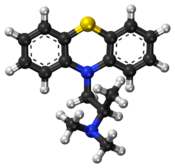User:Mr. Ibrahem/Promethazine
 | |
 | |
| Clinical data | |
|---|---|
| Trade names | Phenergan, many others[1] |
| AHFS/Drugs.com | Monograph |
| MedlinePlus | a682284 |
| Pregnancy category |
|
| Routes of administration | By mouth, rectal, IV, IM, topical |
| Drug class | First-generation antihistamine[2] |
| Legal status | |
| Legal status |
|
| Pharmacokinetic data | |
| Bioavailability | 88% absorbed but after first-pass metabolism reduced to 25% absolute bioavailability[3] |
| Protein binding | 93% |
| Metabolism | Liver glucuronidation and sulfoxidation |
| Elimination half-life | 10–19 hours[3][4] |
| Excretion | Kidney and biliary |
| Identifiers | |
| |
| Chemical and physical data | |
| Formula | C17H20N2S |
| Molar mass | 284.42 g·mol−1 |
| 3D model (JSmol) | |
| Chirality | Racemic mixture |
| |
| |
| (verify) | |
Promethazine is a medication used to treat allergies, trouble sleeping, and nausea.[2] It may help with some symptoms associated with the common cold.[2] It may also be used for sedating people who are agitated or anxious.[7][8] It is available by mouth as a syrup, as a rectal suppository, or by injection into a muscle.[2]
Common side effects include confusion and sleepiness.[2] Alcohol or other sedatives can make this worse.[2] It is unclear if use during pregnancy or breastfeeding is safe for the baby.[2][7] Use is not recommended in those less than two years old due to potentially negative effects on breathing.[2] Use by injection into a vein is not recommended due to potential skin damage.[2] It is a first-generation antihistamine in the phenothiazine family of medications.[2]
Promethazine was made in the 1940s by a team of scientists from Rhône-Poulenc laboratories.[9] It was approved for medical use in the United States in 1951.[2] It is a generic medication and is available under many brand names globally.[1] The wholesale cost of the pills in the United States is less than US$0.20 per dose as of 2018.[10] In the United Kingdom this dose costs less than £0.25.[7] In 2017, it was the 147th most commonly prescribed medication in the United States, with more than four million prescriptions.[11][12]
References[edit]
- ^ a b "Promethazine international brands". Drugs.com. Archived from the original on 2 December 2017. Retrieved 17 July 2017.
- ^ a b c d e f g h i j k l m "Promethazine Hydrochloride Monograph for Professionals". Drugs.com. American Society of Health-System Pharmacists. Archived from the original on 24 October 2018. Retrieved 24 October 2018.
- ^ a b Strenkoski-Nix LC, Ermer J, DeCleene S, Cevallos W, Mayer PR (August 2000). "Pharmacokinetics of promethazine hydrochloride after administration of rectal suppositories and oral syrup to healthy subjects". American Journal of Health-System Pharmacy. 57 (16): 1499–505. doi:10.1093/ajhp/57.16.1499. PMID 10965395.
- ^ Paton DM, Webster DR (1985). "Clinical pharmacokinetics of H1-receptor antagonists (the antihistamines)". Clinical Pharmacokinetics. 10 (6): 477–97. doi:10.2165/00003088-198510060-00002. PMID 2866055.
- ^ "PROMETHAZINE oral - Essential drugs". medicalguidelines.msf.org. Archived from the original on 29 August 2021. Retrieved 24 August 2020.
- ^ "WHOCC - ATC/DDD Index". www.whocc.no. Archived from the original on 26 October 2020. Retrieved 9 September 2020.
- ^ a b c British national formulary : BNF 74 (74 ed.). British Medical Association. 2017. p. 276. ISBN 978-0857112989.
- ^ Malamed, Stanley F. (2009). Sedation: A Guide to Patient Management. Elsevier Health Sciences. p. 113. ISBN 978-0323075961. Archived from the original on 2018-10-25. Retrieved 2018-10-24.
- ^ Li, Jie Jack (2006). Laughing Gas, Viagra, and Lipitor: The Human Stories behind the Drugs We Use. United Kingdom: Oxford University Press. p. 146. ISBN 9780199885282. Archived from the original on January 15, 2020. Retrieved July 9, 2016.
- ^ "NADAC as of 2018-10-24". Centers for Medicare and Medicaid Services. Archived from the original on 2019-06-24. Retrieved 24 October 2018.
- ^ "The Top 300 of 2020". ClinCalc. Archived from the original on 18 March 2020. Retrieved 11 April 2020.
- ^ "Promethazine Hydrochloride - Drug Usage Statistics". ClinCalc. Archived from the original on 8 July 2020. Retrieved 11 April 2020.
